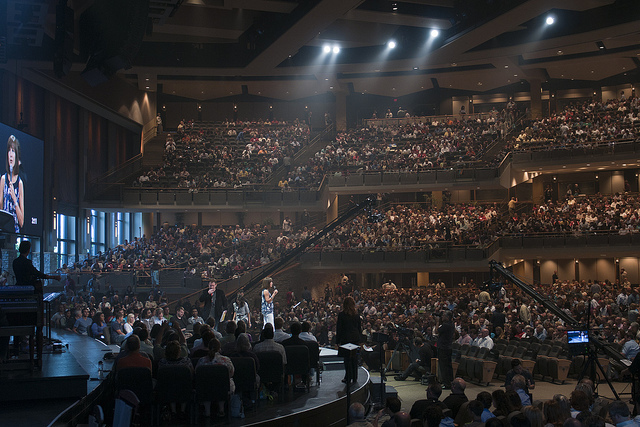Willow Creek Church
Church Encounter Series

On Wednesday night I went to Willow Creek Community Church. Can I tell you that Willow Creek Church is big? When I say "big," you need to adjust your understanding of big. The parking lot is big enough to have numbered sections, and I still couldn't find my car after the service. Driving up to Willow Creek, the building resembles a shopping mall on steroids. When I say "big," don't think of a room that will seat 1,000. Their main auditorium seats 7,500. On a weekend, 20,000 or so folks find their way into Willow Creek. It's the third largest church in the United States, so big takes on a whole new meaning there. I told myself if I ever get a big head from good attendance and people joining my church, I need to visit Willow Creek again and put it into perspective.
Walking into Willow Creek, the place resembles a nice hotel/conference center/mall. There's an indoor waterfall in a big lobby area. You can go have something to eat in a food court and shop in a book store. If you blindfolded someone and took them into the lobby area and then removed the blindfold, the first guess for where they were probably wouldn't be a church. Since I was there on Wednesday night, we were in the smaller Lakeside auditorium,and small for them means it seats 2,000. A man was nice enough, though, to let us see the big room which seats 7,500, and--let me tell you--it's really, really big. There are a couple balconies in there. Every preacher with big-church aspirations doesn't even daydream about a place half this size.
I expected to dislike my experience at Willow Creek, but I was surprised with finding it to be OK. The worship band, which was obviously made of professional musicians, was the best I've ever heard in a church setting. The sermon, which focused on King David's inner life fueling his public life, was really quite good. There was never a red-flag moment where I thought, "That isn't right." I did notice that everyone who appeared on stage was really good looking. Maybe it was only an accident, but the experience would have been a little more authentic for me if everyone in the spotlight didn't look like they also could have a role on a soap-opera.
Willow Creek is one of the most talked about churches of the last few decades. They've been the flag-bearer for the seeker sensitive model. Many, they would say, don't have a church background and don't know what they're doing in a traditional church setting, and churches, according to this model, need to be safe places where seekers can come in and not be threatened. The stained glass and crosses and crucifixes and liturgical furnishings are all absent in a place like Willow Creek. Instead of a traditional liturgy, there might be drama or contemporary music. What happens in a seeker-sensitive service wouldn't seem like church to someone whose spent decades in a traditional church, but those following this model would say they're seeking not those who've been in a church a long time, but those who have little or no experience inside a church.
From what I understand, Willow Creek went through a self-study several years ago, to figure out what was working. You can read more about it here. The results were that their approach of activities and programs wasn't helping people grow in faith. It's one of the critiques I've heard of places like Willow Creek, that the model creates a big congregation of seekers, but it doesn't move people into a more substantial faith. From what I understand (and I'd need to do more research to say this with any authority), the basic approach at Willow Creek hasn't changed substantially since this self-study.
I have no solid place to stand where I could critique Willow Creek. They're dealing with tens of thousands, and I'm dealing with dozens in my ministry. The traditions I've been a part of have usually been no better at encouraging a mature, life-transforming faith. When people have come seeking God, the most mainline churches have offered has been a place on a committee and a seat at the fellowship dinner. I'm in no place to criticize Willow Creek. There's probably more good happening there in one day than I could ever hope to affect in my whole life. But, I will say that what I've been seeking during this sabbatical time is different than what places like Willow Creek offer. I've been interested in the Rule of St. Benedict in his desire to create what he calls "a school for the service of the Lord." Benedict wanted to create a place where people would grow in substantial faith, and I've been curious what the practices are that encourage Christians and churches to grow this way.
I remember years ago growing alfalfa sprouts. They're easy to grow. A friend had a special container for growing them. You put the seeds and water in there, and it wasn't long before there were a bunch of sprouts. The sprouts were good and healthy to eat, but no one would say these were substantial plants. They were little sprouts. What I'm seeking is not how to grow a lot of little sprouts of faith. Instead I want to know what are the practices that encourage a sequoia type of faith, one that's deep and strong and substantial. It seems to me (from my little-informed and hopefully humble perspective) that places like Willow Creek won't show the way there.
"In drawing up its regulations, we hope to set down nothing harsh, nothing burdensome." - Rule of St. Benedict